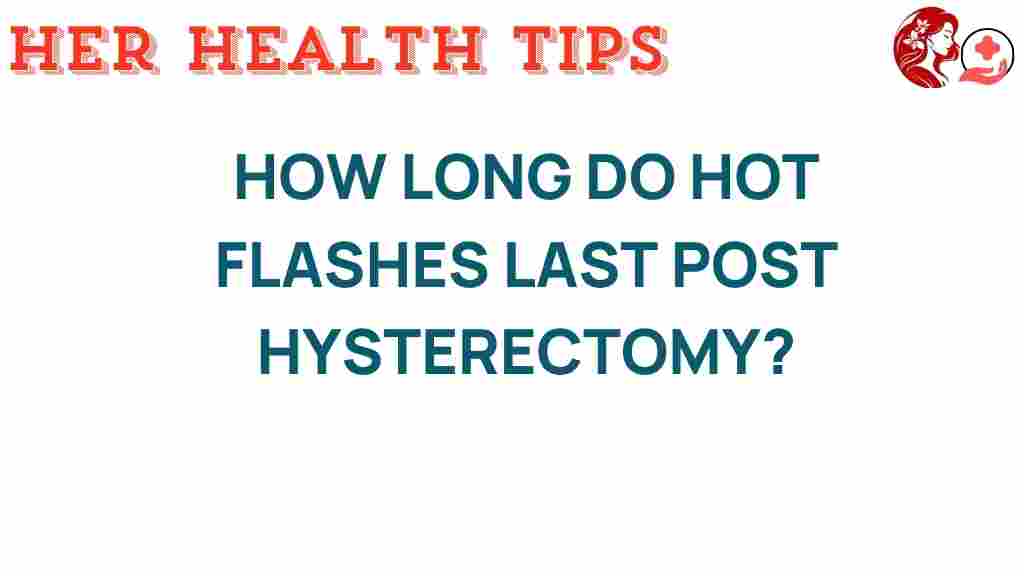Unraveling the Mystery: How Long Do Hot Flashes Last Post Hysterectomy?
Hot flashes are a common symptom experienced by women undergoing menopause, and they can be particularly pronounced after a hysterectomy. Understanding how long these symptoms last is crucial for women’s health, especially for those who have had their ovaries removed during the procedure. In this article, we will explore the duration of hot flashes post-hysterectomy, the factors influencing their severity, and potential treatment options such as hormone therapy.
Understanding Hot Flashes
Hot flashes are characterized by sudden feelings of warmth, typically most intense over the face, neck, and chest. They can be accompanied by sweating, chills, and sometimes, heart palpitations. These symptoms are closely linked to hormonal changes in the body, particularly those that occur during menopause.
The Connection Between Hysterectomy and Menopause
A hysterectomy is a surgical procedure that involves the removal of the uterus. If the ovaries are also removed, this leads to an immediate onset of menopause, known as surgical menopause. This can trigger hot flashes and other menopausal symptoms more abruptly than natural menopause, where hormone levels decline gradually.
Duration of Hot Flashes After Hysterectomy
The duration of hot flashes post-hysterectomy can vary significantly among women. Some of the key factors that influence how long hot flashes last include:
- Age at Surgery: Women who undergo hysterectomy at a younger age may experience longer-lasting symptoms.
- Type of Hysterectomy: A total hysterectomy (removal of the uterus and ovaries) typically leads to more severe symptoms compared to a partial hysterectomy.
- Personal Health History: Women with a history of severe premenstrual syndrome (PMS) or other hormonal issues may experience more intense hot flashes.
- Genetics: Family history can play a role in how long and how severely hot flashes are experienced.
On average, hot flashes can last anywhere from six months to several years. According to studies, about 50% of women report experiencing hot flashes for more than five years after their hysterectomy.
Symptoms Associated with Hot Flashes
Hot flashes are not just a standalone symptom; they often come with other menopausal symptoms, including:
- Night sweats
- Sleep disturbances
- Mood swings
- Dry skin and hair
- Decreased libido
These symptoms can significantly impact a woman’s quality of life, making it essential to seek effective management strategies.
Managing Hot Flashes: Treatment Options
There are several approaches to managing hot flashes, especially for women recovering from a hysterectomy. Here are some common strategies:
1. Hormone Therapy
Hormone therapy (HT) is one of the most effective treatments for hot flashes. It involves the administration of estrogen, and sometimes progesterone, to alleviate menopausal symptoms. Here’s what to consider:
- Benefits: HT can significantly reduce the frequency and intensity of hot flashes.
- Risks: Women should discuss potential risks with their healthcare provider, as hormone therapy may not be suitable for everyone.
2. Lifestyle Modifications
Simple lifestyle changes can also help manage hot flashes:
- Stay Cool: Dress in layers and keep your environment cool.
- Avoid Triggers: Identify and avoid foods or drinks that trigger hot flashes, like caffeine and alcohol.
- Practice Relaxation Techniques: Engaging in yoga, meditation, or deep-breathing exercises can help manage stress and reduce the frequency of hot flashes.
3. Non-Hormonal Medications
For women who cannot or prefer not to use hormone therapy, non-hormonal medications may be an option:
- Antidepressants: Some SSRIs and SNRIs have been shown to reduce hot flashes.
- Gabapentin: Originally used for seizures, this medication can also help alleviate hot flashes.
- Clonidine: This blood pressure medication may help with hot flashes as well.
Recovery After Hysterectomy
The recovery process after a hysterectomy varies for each woman. Here are some critical points to consider:
- Physical Recovery: Post-operative recovery can take several weeks. It’s vital to follow your doctor’s advice regarding activity levels during this time.
- Emotional Recovery: Hormonal changes can affect mood and emotions. Support from loved ones and counseling can be beneficial.
- Regular Check-ups: Follow-up appointments are essential to monitor recovery and manage any ongoing symptoms.
Troubleshooting Common Issues
If you are experiencing persistent hot flashes after a hysterectomy, consider the following troubleshooting tips:
- Keep a Symptom Diary: Track your hot flashes, noting their frequency and triggers. This can help identify patterns and effective management strategies.
- Consult with Your Healthcare Provider: If symptoms are severe or impacting your quality of life, don’t hesitate to seek professional advice.
- Consider Alternative Therapies: Some women find relief through acupuncture, herbal supplements, or other complementary therapies, but always consult your doctor before trying new treatments.
Conclusion
Hot flashes are a common and often distressing symptom following a hysterectomy, particularly when accompanied by immediate menopause. Understanding the duration and management options for hot flashes is crucial for women’s health. While the average duration can vary significantly, effective treatments such as hormone therapy, lifestyle modifications, and non-hormonal medications are available to help manage symptoms.
If you’re struggling with hot flashes or other menopausal symptoms, it’s essential to speak with your healthcare provider to tailor a treatment plan that suits your needs. For more information on women’s health issues, visit this resource and learn more about managing your symptoms effectively.
Remember, you are not alone in this journey, and with the right support and resources, you can navigate through this phase of life with confidence and ease.
This article is in the category Reproductive and created by HerHealthTips Team
